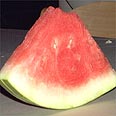
Watermelon: Not just for summer
Watermelon, that spectacular sweet treat that graces picnic baskets and summer tables, is Israel’s favorite summer fruit. And no wonder; with a water content of over 90 percent it’s the ideal fruit to bite into on a hot summer’s day. But watermelon’s goodness is more than skin-deep. So good in fact, that you might want to consider making it a regular part of your year-round diet
An excellent source of antioxidant vitamins C and A and lycopene - which can help boost immunity and ward off disease – watermelon is also a good source of potassium, niacin, vitamin B6 and fiber. Its high water content gives watermelon diuretic properties, often used in cleansing and detoxifying diets. Chinese Medical practitioners use melons to treat bladder and kidney ailments, and its rind to treat diabetes and hypertension. Even the seeds are healthy; watermelon seeds are a source of cucurbocitrin, a substance that dilates blood capillaries, helpful in lowering blood pressure.
Choosing a watermelon
Despite what most people tell you, the best way to know if the watermelon you’ve chosen is really a lemon is to taste it, which is why in Israel it is customary to ask the fruit vendor for a bite, although you might want to adopt one or more of the following methods:
• The look – look for a symmetrical melon with no gashes, cuts or bruises. The bottom should have a large cream-colored (not white or light green) spot on the bottom where your melon sat basking in the sun, and the stem should be green and somewhat dry, never wet, wrinkled or knurled. Melons picked before their prime will never develop their full flavor. If the melon is already cut, make sure there are no mealy edges or white streaks, and the black or brown seeds are not coming away from the flesh. If it is a seedless variety, an abundance of small white immature seeds is an indication that the melon was picked before fully ripened.
• The feel – Pick up the watermelon. It should feel heavy for its size – an indication that the melon is very juicy.
• The knock – Rap the melon with the knuckle of your forefinger or with the whole fist – like knocking on a door. You should hear a deep hollow sound.
Storage and handling
Wash the watermelon under clean running water before placing on a cutting surface to slice. Make sure to wash your hands with soap and water and use clean knives and cutting surfaces. Although whole watermelon may be kept at room temperature for a few days, for best results, store in the refrigerator for up to one week. After cutting, chill and use within a few days.
Watermelon in the kitchen
While for many people eating watermelon is just a matter of slice-and-bite, some people like to cut it into cubes to add to fruit salad, blend it into smoothies or margaritas, freeze the flesh for watermelon popsicles or granita, pickle or curry the rind, carve the shell into a decorative basket and even bake the seeds as a snack. In Israel, the most popular way to eat watermelon is cut into triangles or
chunks with a salty feta-like Bulgarian cheese, sliced or sprinkled on top. But
for enterprising Israeli chef and artisan baker Erez Komorovsky, it was
the inspiration to create the exotic combinations in the recipes that
follow.
Watermelon, feta cheese and basil salad
There are many variations on this simple salad, some using fresh sage
or mint leaves instead of basil, some adding black olives or sliced red onion,
some substituting other kinds of cheese like Camembert. This version blends hot and cold, salty and sweet for a new watermelon experience.
Serves 6-8
¼ medium-sized watermelon, regular or seedless
8 ounces feta cheese
1 cup extra virgin olive oil
fistful of fresh basil or sage leaves
freshly ground black pepper to taste
Using a sharp knife, cut the ¼ watermelon lengthwise down the center, and
then away from the rind, yielding two sets of triangles. Remove the seeds if
desired, cover tightly and chill till serving time. Just before serving, place on a large platter with raised sides (so the olive oil will not spill out). Cut the feta cheese into cubes and sprinkle over the watermelon.
Heat the olive oil till hot but not boiling, remove from heat, stir in the basil or sage leaves, and pour over the watermelon and cheese. Season with a generous amount of freshly ground black pepper and serve immediately with warm toasted pita, chunks of fresh country-style bread, forks and a glass of chilled wine.
Erez Komorovsky's watermelon, red onion and blackberry salad
2- 2 1/4 pounds watermelon, rind removed and cut into chunks
2 small red onions, peeled and sliced lengthwise
5 ounces ripe goat cheese, crumbled
1 cup fresh blackberries or raspberries
juice of one and a half lemons
1 tablespoon sugar
coarsely ground white pepper to taste
bunch of watercress or arugula leaves, stems removed
In a small bowl, mix the lemon juice and sugar and gently add the blackberries. Set aside one hour. Transfer the watermelon, red onion and watercress leaves to a large serving platter, and sprinkle the cheese, white pepper, and finally the berries and lemon juice on top. For lovers of spicy food, Erez suggests adding a finely minced fresh chili pepper to the lemon juice along with the berries.
Phyllis Glazer is a freelance foodwriter with a regular blog on YNET in Hebrew. She is also the author of The Essential Book of Jewish Festival Cooking with her sister Rabbi Professor Miriyam Glazer, published by Harper-Collins. Comments and culinary queries can be sent to [email protected].










